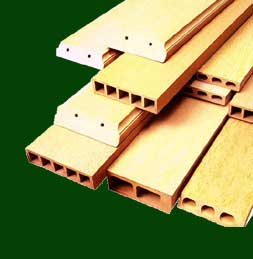
A | B | C | D | E | F | G | H | CH | I | J | K | L | M | N | O | P | Q | R | S | T | U | V | W | X | Y | Z | 0 | 1 | 2 | 3 | 4 | 5 | 6 | 7 | 8 | 9
The examples and perspective in this article may not include all significant viewpoints. (December 2010) |
A fiber-reinforced composite (FRC) is a composite building material that consists of three components:[1][2]
- the fibers as the discontinuous or dispersed phase,
- the matrix as the continuous phase, and
- the fine interphase region, also known as the interface.
This is a type of advanced composite group, which makes use of rice husk, rice hull,rice shell, and plastic as ingredients. This technology involves a method of refining, blending, and compounding natural fibers from cellulosic waste streams to form a high-strength fiber composite material in a polymer matrix. The designated waste or base raw materials used in this instance are those of waste thermoplastics and various categories of cellulosic waste including rice husk and saw dust.

Introduction
FRC is high-performance fiber composite achieved and made possible by cross-linking cellulosic fiber molecules with resins in the FRC material matrix through a proprietary molecular re-engineering process, yielding a product of exceptional structural properties.
Through this feat of molecular re-engineering selected physical and structural properties of wood are successfully cloned and vested in the FRC product, in addition to other critical attributes to yield performance properties superior to contemporary wood.
This material, unlike other composites, can be recycled up to 20 times, allowing scrap FRC to be reused again and again.
The failure mechanisms in FRC materials include delamination, intralaminar matrix cracking, longitudinal matrix splitting, fiber/matrix debonding, fiber pull-out, and fiber fracture.[1]
Difference between wood plastic composite and fiber-reinforced composite:
| Features | Plastic lumber | Wood plastic composite | FRC | Wood |
|---|---|---|---|---|
| Recyclable | Yes | No | Yes | Yes |
| House Construction | No | No | Yes | Yes |
| Water Absorption | 0.00% | 0.8% and above | 0.3% and below | 10% and above |
Properties
| Tensile Strength | ASTM D 638 | 15.9 MPa |
| Flexural Strength | ASTM D 790 | 280 MPa |
| Flexural Modulus | ASTM D 790 | 1582 MPa |
| Failure Load | ASTM D 1761 | 1.5 KN - 20.8 KN |
| Compressive Strength | 20.7MPa | |
| Heat Reversion | BS EN 743 : 1995 | 0.45% |
| Water Absorption | ASTM D 570 | 0.34% |
| Termite Resistant | FRIM Test Method | 3.6 |
Basic principles
The appropriate "average" of the individual phase properties to be used in describing composite tensile behavior can be elucidated with reference to Fig. 6.2. Although
this figure illustrates a plate-like composite, the results that follow are equally applicable to fiber composites having similar phase arrangements. The two phase
material of Fig. 6.2 consists of lamellae of and phases of thickness and . and respectively. Thus, the volume fractions (, ) of the phases are and .
Case I: Same stress, different strain
A tensile force F is applied normal to the broad faces (dimensions Lx L) of the phases. In this arrangement the stress borne by each of the phases (= F/) is the same, but the strains (, ) they experience are different. composite strain is a volumetric weighted average of the strains of the individual phases.
,
The total elongation of the composite, is obtained as
and the composite strain is, ===
Composite modulus
Case II: different stress, same strain
Fibers that are aligned parallel to the tensile axis, the strains in both phases are equal (and the same as the composite strain), but the external force is partitioned
unequally between the phases.
Deformation behavior
When the fiber is aligned parallel to the direction of the matrix and applied the load as the same strain case. The fiber and matrix has the volume fraction , ; stress , ; strain,; and modulus ,
Antropológia
Aplikované vedy
Bibliometria
Dejiny vedy
Encyklopédie
Filozofia vedy
Forenzné vedy
Humanitné vedy
Knižničná veda
Kryogenika
Kryptológia
Kulturológia
Literárna veda
Medzidisciplinárne oblasti
Metódy kvantitatívnej analýzy
Metavedy
Metodika
Text je dostupný za podmienok Creative
Commons Attribution/Share-Alike License 3.0 Unported; prípadne za ďalších
podmienok.
Podrobnejšie informácie nájdete na stránke Podmienky
použitia.
www.astronomia.sk | www.biologia.sk | www.botanika.sk | www.dejiny.sk | www.economy.sk | www.elektrotechnika.sk | www.estetika.sk | www.farmakologia.sk | www.filozofia.sk | Fyzika | www.futurologia.sk | www.genetika.sk | www.chemia.sk | www.lingvistika.sk | www.politologia.sk | www.psychologia.sk | www.sexuologia.sk | www.sociologia.sk | www.veda.sk I www.zoologia.sk






























